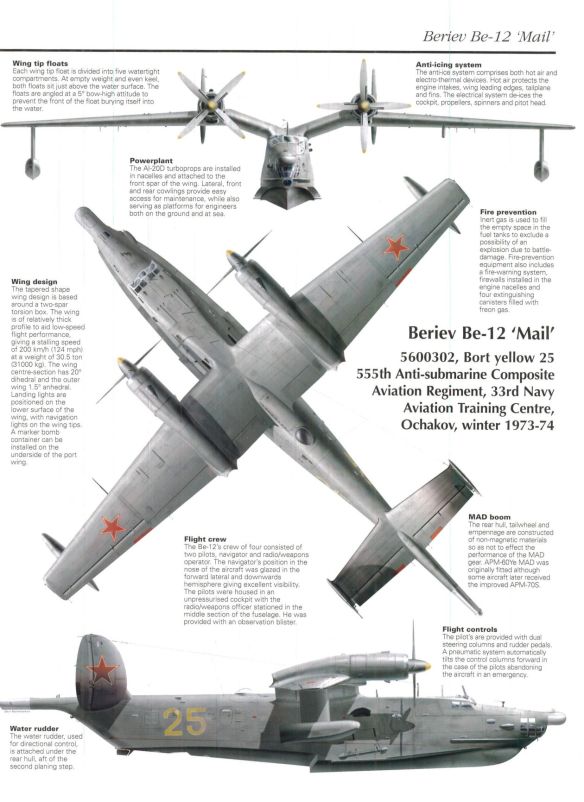
Together with the Japanese Maritime Self-Defence Force, the AV-MF (Soviet Naval Aviation) is the last major service to operate fleets of combat flying-boats and amphibians. Elsewhere, the role of the patrol flying-boat was taken over by long-range landplanes in the 1950s. This process may continue, as no amphibious replacement for the Beriev Be-12 Tchaika (Seagull), codenamed ‘Mail’ by NATO, has been reported, and the AV-MF has introduced specialised landplanes for the anti-submarine role, the llyushin 11-38 ‘May’ and the Tupolev Tu-142 ‘Bear-F’.
The Beriev design bureau, based at Taganrog on the Sea of Azov, has been the main supplier of marine aircraft to the Soviet Navy since 1945, most of its aircraft going to the Northern and Black Sea Fleets. The origins of the Be-12 go back to the LL-143 prototype of 1945, which led in 1949 to the Be-6 ‘Madge’. This latter twin-engined flying-boat served with success until 1967.
Following the Be-6, the Beriev team carried out a considerable amount of research into jet-powered flying-boats, producing the straight-winged Be-R-1 of 1952 and the swept-wing Be-10 of 1960-1. The latter, powered by two Lyul’ka AL-7RVs (unaugmented versions of the Su-7 powerplant), established a number of seaplane records in 1961, but only three or four are believed to have been built.
The lessons learned in the design of the Be-R-1 and Be-10, however, were incorporated in the design of a much improved flying-boat based loosely on the Be-6 and identified originally by NATO as a re-engined version of the older type. In fact, the Be-12, designated M-12 in AV-MF service, bears little more than a general resemblance to the Be-6, sharing only the gull-wing layout and twin tail of its predecessor. The greater power and lighter weight of the turboprop engines have permitted a forward extension of the hull, with a new planing bottom similar to that of the Be-10. The prominent spray suppressor around the bows of the Be-10 is also a feature of the turboprop aircraft. The most significant change, however, was the addition of massive and sturdy retractable landing gear, making the Be-12 amphibious and thus considerably more versatile than the earlier Beriev designs. The turreted gun armament of the Be-6 has been deleted, being replaced by MAD (magnetic anomaly detection) gear in the tail, above the tailwheel well, while the search radar is carried in a long nose housing instead of the ventral retractable dustbin radome of the Be-6. One of the drawbacks of the high-wing layout, the excessive height of the engines above the ground, has been mitigated by the design of engine cowling panels which drop down to form strong working platforms.
The considerable weight-lifting capability of the Be-12 was demonstrated in a series of class records for amphibians set up in 1964, 1968 and 1970, suggesting a normal weapons load as high as 5000kg (11,023lb). The Be-12 can load on the water through large side hatches in the rear fuselage, and stores can be dropped through a watertight hatch in the hull aft of the step. Unlike land-based ASW platforms, a marine aircraft can, in reasonably calm conditions, settle on the water, and search with its own sonar equipment, rather than relying exclusively on sonobuoys. This assumes that the Be-12 has this capability.
With the increasing use of the Mil Mi-14 ‘Haze’ ASW helicopter and the llyushin II-38 ‘May’, there would seem to be a diminishing ASW role for the Be-12, although the type will certainly remain in service as a high-speed search-and-rescue (SAR) vehicle. It is also believed to have been used for mapping, geophysical survey and utility transport. By Soviet standards the type was not built in large numbers, only 95 being reported in service in the late 1980s.
Variants
Ukrainian Be-12
Be-12
Twin-engined maritime reconnaissance, anti-submarine warfare flying-boat.
Be-12EKO
Ecological reconnaissance version.
Be-12LL
Flying laboratory version.
Be-12Nkh
Utility transport, experimental passenger trasport version.
Be-12PS
Search and rescue version.
Be-12P
Fire-fighting version.
Firefighting version.
Be-12SK
Used for nuclear depth charge tests.
Be-121
Scientific research version.